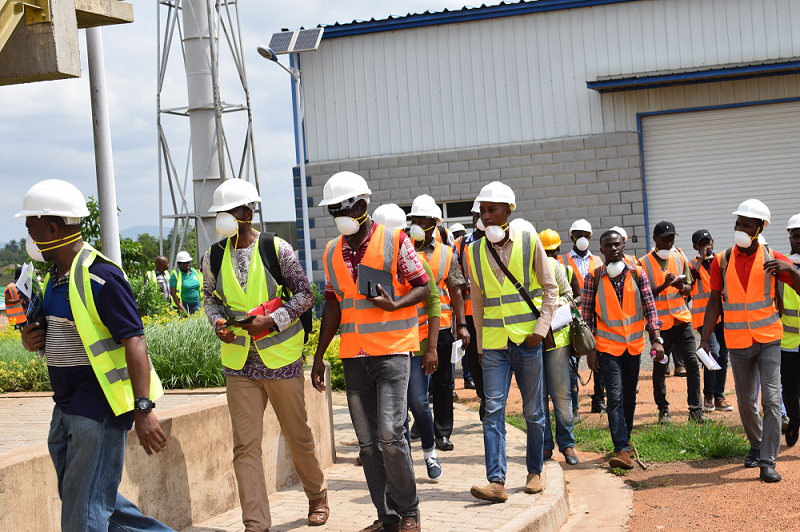|
Fellows & Students at ACARP, Adjen Kotoku |
Research fellows and students (PhD & Masters) from the Institute for Environment and Sanitation Studies (IESS) have embarked on a field visit to selected areas of environmental interest within the Greater Accra Region. The visit was designed to broaden students’ understanding while exposing them to the practical environmental issues such as sanitation, pollution, land use and planning, natural resource management within the metropolis.
The five-day (4-8 February) trip took the team to the Accra Compost and Recycling Plant (ACARP), Kotoku, Lavender Hill and Mudor Faecal Treatment facilities respectively. ACARP, located at Agyen Kotoku is a recycling plant focused on the production of compost from mixed municipal waste, the Mudor Faecal Treatment Plant consists of a 95km, 18,000m3/day sewer network (Accra CBD Sewer Network) which serves the Korle-Bu, State House, Ministries, Osu/Labone and High Street areas in Accra. The new Lavender Hill Faecal Treatment Facility on the other hand has the capacity of receiving 2000m3/day, an equivalent of 250 trucks of sewerage per day for treatment. These three plants make up the Accra Sewerage Treatment Plants and are managed by the Sewerage Systems Ghana (SSGL) through a Public Private Partnership (PPP) with the Ministry of Local Government and Rural Development.
The Mobile Integrated Solid Waste Management Facility, Jakora Waste Company (a PPP involving the local communities in the production of compost from food waste), the Weija Water Works, and the Weija Irrigation Scheme at Tuba were also visited. At each of these stops, the team was briefed on the operational processes and challenges associated with the workings of these facilities as well as their contributions to the maintenance of the environment and environmental quality and or resources.
|
|
During our stop at the Lavender Hill and Mudor Faecal Treatment Facilities in Accra, we had a privileged interaction with Dr. Joseph Siaw Agyepong, Executive Chairman of the Zoomlion Group of which the SSGL is a subsidiary. The fruitful interactions explored possible collaborations between the Zoomlion Group of Companies and the Institute. Dr. Siaw Agyepong expressed his burning desire to see academics/researchers and entrepreneurs collaborate. He thus urged the Institute to do all it can to ensure that it brings entrepreneurs on board its activities with the objective of enhancing support for its activities in a bid to promote environmental awareness in the country.
|
Fellows & Students interacting with Dr. Siaw Agyepong |
The team also visited two communities; Glefe near Dansoman (where a new sea defense has been erected) in Accra and Totope near Ada Foah, impacted by coastal flooding and erosion. To crown it with some fun and the observation of nature at work, we visited the Volta estuary located at Azizanya (Ada) and the Shai Hills Resource Reserve.
|
A section of the newly constructed Sea Defense Wall at Glefe in Dansoman |
The trip has served as a great eye opener, an opportunity to observe at first hand practical aspects of the things learnt in the classroom concerning the environment. For some students, it has given them a direction to focus for future research activities while others believed it has enabled them understand the primary causes of the existing gaps in science-policy and practice. Beyond seeing new places and understanding the practical applications of theoretical concepts, the trip has led to improved interpersonal relations as many of the students have for the first time interacted more closely with other colleagues of the Institute. Working in teams to produce various forms of reports emanating from the visit is also encouraging team spirit among students as they learn to consider diversity of views as well as learn new concepts and skills in scientific writing and reporting processes.
|
A Senior Research Fellow & students atop the Shail Hills Resource Reserve rocks |


